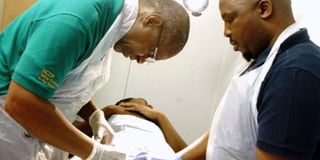How ring and traditional circumcision methods work

Since foreskin traps bacteria and other infectious agents, its removal may improve genital hygiene and reduce risk of disease over the lifetime of the boy and his future sexual partners. Net photo
There are several surgical methods for circumcision. The choice depends on skill and preference of medical personnel performing the surgery. Dr Dennis Buwembo, a public health specialist, defines male circumcision as the removal of the foreskin, the fold of skin that covers the head of the penis.
“It is an age old procedure which is done for cultural reasons for example among the Gishu people, for religious reasons like in Islam, social reasons, and medical reasons,” he explains, adding that techniques include dorsal slit, sleeve resection and forceps-guided methods. ‘Ring’ methods are also used, preferably for children.
For 41-year-old Nyansio Mulyowa, going for circumcision was something that had made runs in his mind for about seven years. “Radio campaigns encouraged men to go and get circumcised and I knew I had to do it,” he explains. “I had made up my mind but still feared to face the knife, like it is called.
When I arrived at the clinic, I confidently paid for the procedure but when another person, who had just finished the procedure walked out, I almost left the clinic. He looked so weak and in pain. The nurse, perhaps sensing my fear counselled me and assured me that the procedure would not be painful,” Mulyowa further recounts.
The procedure
Two rubber rings were used. One was put inside the foreskin of his penis and another outside. “A nurse said the outside ring would help in blocking blood from flowing to the foreskin. Her explanation started to make sense when the foreskin began falling off gradually. Within a week, I had completely healed and the skin had dried up,” he says.
Dr Linda Katusabe, a plastic and reconstructive surgeon, says the dorsal slit is the most commonly used method worldwide. “Surgery is done under direct vision leaving less risk of accidental injury to the urethra or amputation of glans/penis, and better control of bleeding,” she says.
Ring circumcission
“Ring circumcision works the same way extra fingers on a child’s hand are dealt with. The mechanism is to cut off blood supply to the foreskin with eventually dries off and breaks or is assisted to fall off the penis,” Dr Buwembo explains.
Dr Katusabe adds that the method uses a device with circular/ring-like clamps that are assembled and tightened over the foreskin at a desired level to crush the foreskin before it is cut off using scissors/scalpel. “Crushing enables the removal of the foreskin with minimal bleeding and also requires minimal or no suturing. It is also a quick procedure but requires close monitoring,” the surgeon adds.
The methods compared
When compared to the dorsal or conventional method, Dr Buwembo observes that with the ring method of circumcision, many people can be reached with the service in a very short time. He adds that the ring method takes little time and consumes less health supplies. In absence of a doctor, Dr Buwembo says other health professionals such as nurses can also perform the procedure.
“When done carefully, it has been shown to have less risk of glans or penile amputation and urethral injury, although some risks still exist,” Dr Katusabe observes, adding that the method does not call for suturing and the patient bleeds less compared to the dorsal method.
Dr Buwembo also observes that the disadvantages of the method include the need for multiple rings/clamps with variable sizes, close follow up and in some cases, dorsal slit and suturing are required.
Advantages of circumcission
Generally speaking, Dr Buwembo says circumcision helps improve genital hygiene as the penis is easier to clean. It also reduces risk of urinary tract infections in childhood, the risk of genital infections, especially sexually transmitted infections particularly the ulcerative diseases such as chanchroid and syphilis. Circumcision also reduces chlamydia and HPV infections.
“With circumcision, a man has reduced risk of acquiring HIV infection, penile cancer and reduced risk of cervical cancer in female partners, which cancers are associated with HPV infection. It also prevents development of inflammation of foreskin (balanitis) and other complications such as phimosis (inability to retract foreskin) and paraphimosis (inability to pull back foreskin over the glans after it has been retracted),” Dr Buwembo adds.
Recovery in babies
Call your child’s doctor if your child has any of the following:
• Continued fussiness (in babies)
• Increased pain (in children)
• Trouble with urination
• Fever
• Foul-smelling drainage
• Increased redness or swelling
• persistent bleeding
• A plastic ring that doesn’t fall off after two weeks
In adults
Call your doctor if you have any of the following:
• Increased pain
• Trouble urinating
• Bleeding
• Signs of infection including fever, increased redness, swelling, or drainage.




